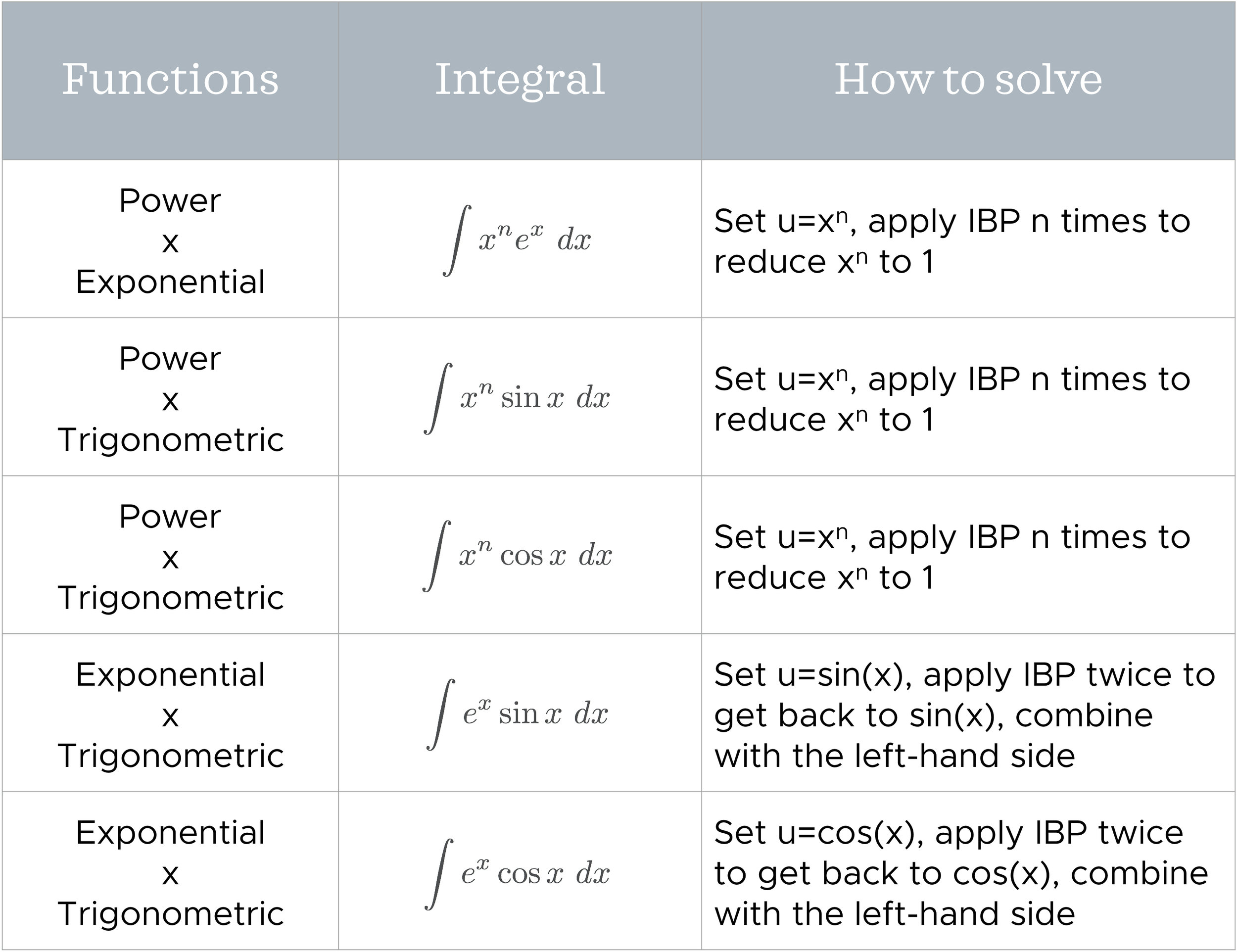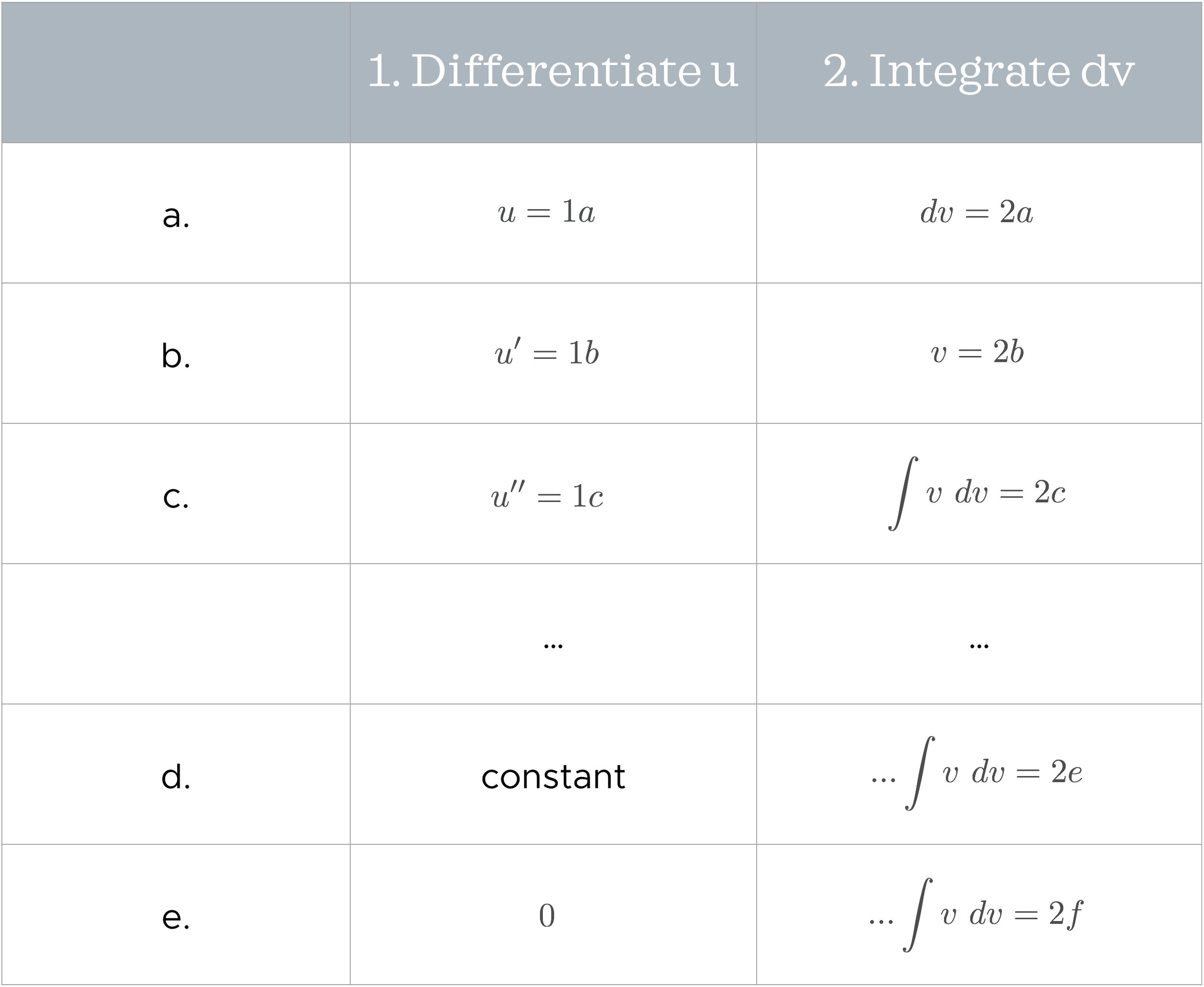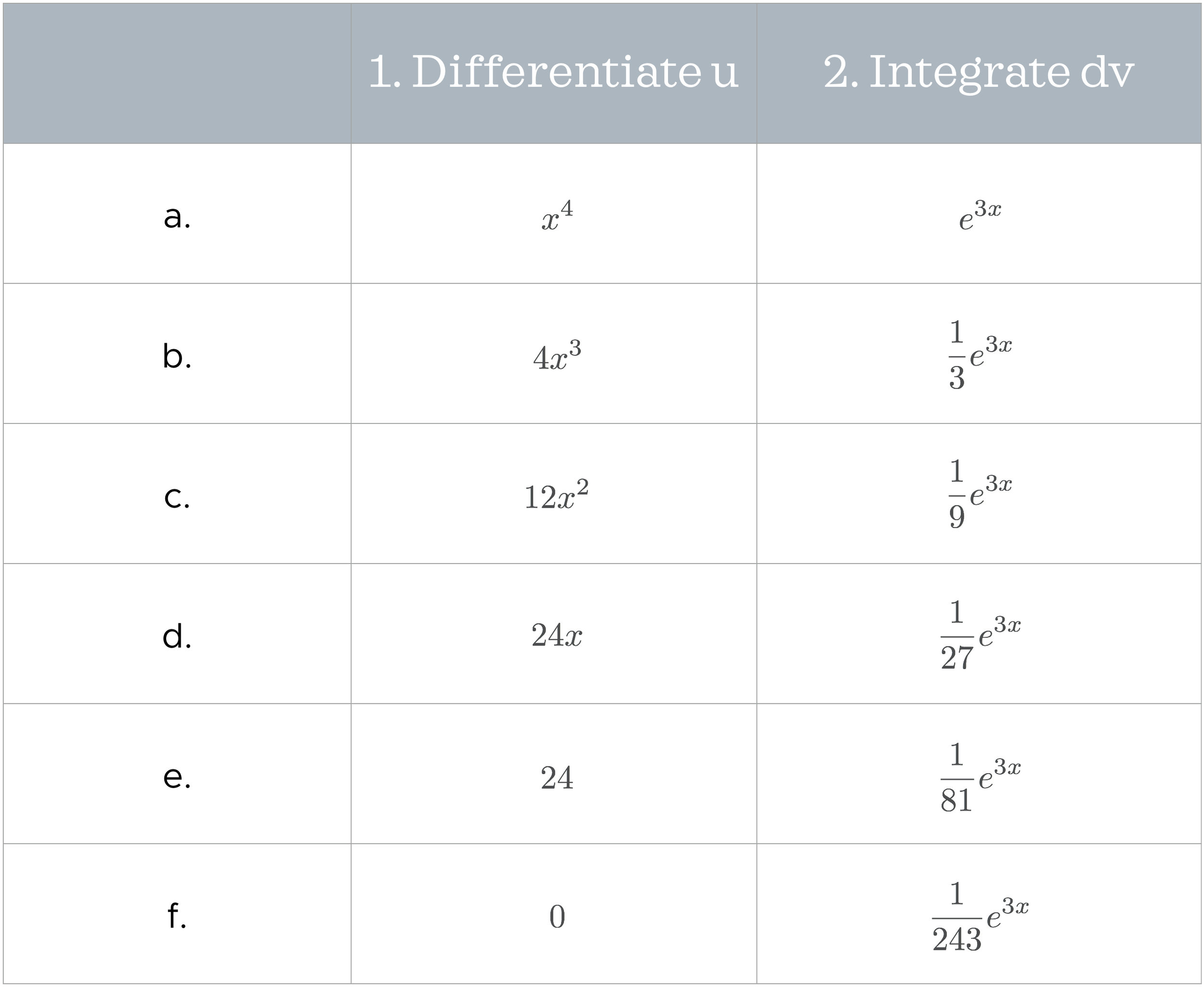integration by parts: Everything you need to know
By Krista King
This guide will walk you through everything you need to know about integration by parts, including when to use integration by parts, the IBP formula, how to pick ???u??? and ???dv???, and everything else about using integration by parts to solve integrals.
What you’ll get in this guide:
What is integration by parts?
When should you use integration by parts?
The integration by parts formula. How is the integration by parts formula derived?
How to pick values for u and dv using the LIPET or LIATE rule
How to solve integration by parts problems
Applying integration by parts multiple times (two times and three times)
Tabular integration: an alternative to integration by parts
Integration by parts and reductions formulas
Download the IBP study guide, and lots of IBP practice problems!
What is integration by parts?
Here’s a quick intro.
Like u-substitution, integration by parts (or "IBP") is just a method we use to rewrite integrals so that they're easier to evaluate.
We only use integration by parts when the function we're trying to integrate is itself the product of two functions. For example, the function ???f(x)=e^x\sin{x}??? is the product of ???e^x??? and ???\sin{x}???. So if we were asked to integrate this function, integration by parts is something we'd probably want to try, since it's built for just that purpose.
Key point: Use integration by parts when you need to integrate the product of two functions.
When should you use integration by parts?
Use integration by parts when you’re integrating the product of two functions
You already know to use integration by parts when you’re integrating the product of two functions. But the kinds of functions matter. When it comes to integration by parts, remember PET: Power, Exponential, Trigonometric.
A power function is like a term you’d see in a polynomial: ???x???, ???x^2???, and ???x^3??? are all examples.
An exponential function is anything that involves the number ???e???: ???e^x??? and ???e^{-x}??? are examples.
A trigonometric function is anything involving one of the six trig functions: ???\sin{x}???, ???\cos{x}???, ???\tan{x}???, ???\csc{x}???, ???\sec{x}???, and ???\cot{x}???. The sine and cosine functions are the ones you’ll see most often.
Integration by parts will usually be used when you’re integrating the product of two of these three kinds of functions. For example, one power and one exponential function, or one exponential function and one trigonometric function. These are the possible combinations:
Power x Exponential
???\int xe^{-x}\ dx???
Power x Trigonometric
???\int x^2\cos{x}\ dx???
Exponential x Trigonometric
???\int 2e^x\sin{x}\ dx???
These aren’t the only possible combinations, but they are by far most common kinds of functions you’ll deal with when it comes to solving integration by parts problems. ???\int x\ln{x}\ dx??? is an example of an integral that doesn’t follow this pattern. It’s the product of a power function and a logarithmic function, which doesn’t follow the PET format, but still requires integration by parts.
Which means that this “PET” idea is just a guideline. It’s not perfect and doesn’t account for 100% of all integration by parts problems. But it is a great guideline. If you see the product of two PET functions, you should immediately think of integration by parts.
Key point: Use integration by parts to integrate the product of two PET functions: power function, exponential function, trig function.
Use integration by parts when u-substitution doesn’t work
The more you practice these integration by parts problems, the faster you’ll get at this, but in your own head you should always ask yourself two questions really quickly before you jump into using integration by parts to solve an integral:
1. Can I integrate the function directly? Some functions don’t need any fancy integration techniques at all. You can just solve them directly. For instance, polynomial functions like this one can be integrated term-by-term, without any manipulation:
???\int x^3+3x^2+2x+1\ dx???
???\frac14x^4+\frac33x^3+\frac22x^2+x+C???
???\frac14x^4+x^3+x^2+x+C???
2. Can I use u-substitution to solve the integral instead? U-substitution is easier and faster to use than integration by parts. So if u-substitution does the trick, there’s no need to bother with integration by parts.
Side note here: Most of the time, you’ll only use EITHER u-substitution OR integration by parts in a single problem. It’s usually one or the other, which is why you can check to see whether u-substitution works, and then only if doesn’t, go on to integration by parts. But for some problems, you’ll need to use u-substitution AND integration by parts to solve the integral. We’ll talk about that scenario a little bit later in this guide.
The integration by parts formula
Product rule for derivatives, integration by parts for integrals
If you remember that the product rule was your method for differentiating functions that were multiplied together, you can think about integration by parts as the method you’ll use for integrating functions that are multiplied together.
Suppose you want to integrate the following
???\int xe^{-x}\ dx???
How can you integrate the above expression quickly and easily? Hopefully you can recognize that you have two functions multiplied together inside of this integral, one being ???x??? and the other being ???e^{-x}???.
If you try u-substitution, you won’t find anything to cancel in your integral, and you’ll be no better off, which means that your next step should be an attempt at integrating with our new method, integration by parts.
Because ???x??? is a power function and ???e^{-x}??? is an exponential function, the integrand (that’s what we call the function that’s inside the integral, the one we’re trying to integrate) is the product of a power function and an exponential function, which means it meets the PET rule that we talked about earlier.
Which means we should really now try to run this integral through the integration by parts formula:
???\int u\ dv=uv-\int v\ du???
We’ll dig into this more, but let’s just recognize the basics of this formula. What it’s telling us is that, if you start with the integral on the left side of the equation, ???\int u\ dv???, that you can rewrite it as the expanded expression on the right side of the equation, ???uv-\int v\ du???.
Notice that the integral on the left side is the integral of the product of two values: ???u??? and ???dv???. You already know that integration by parts lets you integrate the product of two functions. So the connection we want to make here is that one of those functions has to be ???u???, and the other one has to be ???dv???.
Your job will be to decide which of the functions should be ???u???, and which one should be ???dv???. Once you do, you’ll use those to find two more values: ???du???, which is just the derivative of ???u???, and ???v???, which is the integral of ???dv???.
Key point: Your job is to identify which part of your original function will be ???u???, and which will be ???dv???.
If you look again at the right side of the integration by parts formula, you’ll see all four of those values on that side: ???u???, ???v???, ???du???, and ???dv???. Once you have them, you’ll just be plugging those four values into the right side of the integration by parts formula. If you’ve done this correctly, the integral you have left should be easier than the one you started with.
How is the integration by parts formula derived, and why does it work?
The IBP formula comes directly from the product rule for derivatives. In case you don’t remember the product rule, here it is:
???\frac{d}{dx}\left[f(x)g(x)\right]=f'(x)g(x)+f(x)g'(x)???
It tells us that the derivative of the product of two functions is equal to the sum of the first function times the derivative of the second, and the second function times the derivative of the first.
The product rule for derivatives is what you use when you want to differentiate the product of two functions. Integration by parts is what you use when you want to integrate the product of two functions. The integration by parts formula is
???\int u\ dv=uv-\int v\ du???
The integration by parts formula is derived by integrating the product rule formula. Here’s a video that explains how to prove the integration by parts formula:
In the video below, we’ll walk through how the integration by parts formula is derived. Because we know that the product rule for derivatives gives us the derivative of the product of two functions, it makes sense that we might be able to integrate that rule to get a rule that works for the integral of the product of two function.
How to pick u and dv (using LIPET or LIATE)
When it comes to picking which function in the given integrand will be ???u??? and which one will be ???dv???, we really want to focus on picking ???u??? first. The reason is because ???u??? will always just be one of the functions that makes up the integrand.
Once we have ???u???, then ???dv??? will always be everything else in the integral, which will include the other function (the one we didn’t pick for ???u???), and the ???dx??? that came with the integral.
Key point: Pick ???u??? first. Then ???dv??? is automatically everything else: the function you didn’t pick for ???u???, and the ???dx??? that came with the integral.
So how do decide which function will be ???u???? Remember how we said before that the PET rule (power functions, exponential functions, trigonometric functions) was really more of a guideline, and less of a rule? Well the same is true when we talk about LIPET and LIATE: they’re more of a guideline than a rule, and they don’t always work.
But let’s give them a chance before we discount them too much. LIPET stands for
L = Logarithmic function
I = Inverse trigonometric function
P = Polynomial function
E = Exponential function
T = Trigonometric function
LIPET is a guideline we can use to pick which of the functions in the integrand should be ???u???. It’s pretty simple actually, you just go right down the list. If you have a logarithmic function as part of the integrand, then set that equal to ???u???. If you don’t have a log function, but you have an inverse trig function, then the inverse trig function should be ???u???. If you don’t have either of those, but you have a polynomial function, then the polynomial function should be ???u???. And on down through the rest of the list. Some people prefer to follow the LIATE rule, rather than the LIPET rule. LIATE stands for
L = Logarithmic function
I = Inverse trigonometric function
A = Algebraic function
T = Trigonometric function
E = Exponential function
If you compare LIPET to LIATE, you see that the first two are the same: they both start with logarithmic and then inverse trig functions. “Polynomial” and “Algebraic” are just two different ways of saying the same thing. They both refer to the kinds of power functions that we talked about in the PET guideline earlier, functions like ???x???, ???x^2???, or ???x^3???. So LIPET and LIATE are actually identical through the first three functions. Notice though that the last two functions are flipped. LIPET tells you to pick an exponential function over a trigonometric function, but LIATE tells you to pick a trigonometric function over an exponential function.
So which one is right? Unfortunately, and please don’t shoot the messenger here, it just depends. Like I said, neither of these is a hard and fast, perfect, works-every-time rule. They’re good guidelines, and you should think about them as a great place to start. But you should be willing to bend these rules.
And here’s another important thing: Don’t be afraid to fail! The good news is that you’ve only got two functions in the integrand. So try it both ways! Set ???u??? equal to one function and ???dv??? equal to the other. Run it through the IBP formula and see if you come out with an integral that you can easily evaluate. If you did, then great! Solve the integral and finish the problem. But if the integral still looks nasty and you’re still not sure what to do with it, go back and switch your ???u??? and ???dv???. Run this reverse setup through the formula and see what integral it gives you.
Be aware that, even if you get a tough integral after applying the integration by parts formula, your ???u??? and ???dv??? setup might still have been correct. Maybe it’s just the case that the integral you’re still left with is just difficult, or you don’t immediately recognize how to solve it. That doesn’t mean your ???u??? and ???dv??? choices were necessarily wrong.
The key here is that you’ll get better and better at these the more you practice. So keep working at it and playing around with these problems.
Key point: Don’t be afraid to fail! Don’t be paralyzed by picking a ???u??? and ???dv???. If you’re not sure, try it one way and see if you come out with a simpler integral. If the integral still seems tough, go back to the beginning and try it the other way. You’ll get pretty fast at running integrals through the IBP formula, so you can afford to take the time to try it both ways if you need to.
My own favorite way to identify u and dv
Personally, my favorite technique for picking ???u??? and ???dv??? is to think about assigning ???u??? to the function in your integral whose derivative is simpler than the original ???u???. Consider again the example from earlier:
???\int xe^{-x}\ dx???
When I look at this, I would assign ???u??? to ???x???, because the derivative of ???x??? is ???1???, which is much simpler than ???x???. If you have ???\ln{x}??? in your integral, that’s usually a good bet for ???u??? because the derivative of ???\ln{x}??? is ???1/x???; much simpler than ???\ln{x}???.
On the other hand, if I were to assign ???u??? to be ???e^{-x}???, that doesn’t really get me anywhere, since the derivative of ???e^{-x}??? is ???-e^{-x}???, which isn’t really any simpler at all than ???e^{-x}???.
I always like to keep this idea of the derivative ???du??? being simpler than the original function ???u??? whenever I’m trying to pick my ???u???. So there you have it; another rule of thumb for you.
How to solve integration by parts problems in 4 simple steps
Let’s go through an example so you can see how to pick ???u??? and ???dv???, and how to plug them into the integration by parts formula.
Example #1: Power function x Exponential function
Use integration by parts to solve the integral.
???\int xe^{-x}\ dx???
Step 1: Picking ???u??? and ???dv???
The hardest part of an integration by parts problem is picking the value of ???u???. But once you choose the correct value for ???u???, ???dv??? is automatically everything else in the integral: the other function that you didn’t pick for ???u???, and the ???dx??? that was part of the integral.
Our integral is comprised of two functions, ???x??? and ???e^{-x}???. One of them must be ???u??? and the other ???dv???. If we use LIPET or LIATE, we’d set ???u=x???, since ???x??? is an polynomial, or algebraic, function, and those kinds of functions come before exponential functions in LIPET/LIATE.
Setting ???u=x??? also follows my personal rule: Since the derivative of ???x??? is ???1???, which is much simpler than the derivative of ???e^{-x}???, we’ll assign ???u??? to ???x???.
Step 2: Find ???du??? and ???v???
Having identified your ???u??? and ???dv???, your next step is to take the derivative of ???u???, which will give you ???du???, and take the integral of ???dv???, which will give you ???v???.
With ???u=x???, the derivative of ???u??? is ???du/dx=1??? or ???du=dx???
With ???dv=e^{-x}\ dx???, the integral of ???dv??? is ???v=-e^{-x}???
Step 3: Plug everything into the IBP formula
Now that you have ???u???, ???du???, ???v??? and ???dv???, you can plug all of the pieces into the right side of the integration by parts formula from earlier. Everything to the right of the equals sign will be part of your answer.
Plugging all four components into the right side of our formula gives the following transformation of our original function:
???\int xe^{-x}\ dx=(x)(-e^{-x})-\int (-e^{-x})(1\ dx)???
???\int xe^{-x}\ dx=-xe^{-x}+\int e^{-x}\ dx???
This is the step where you see the beauty of integration by parts! You can see the integral that we started with on the left side of the equation, but look at the integral that remains on the right side of the equation. All that’s left is the integral of ???e^{-x}???! And that’s a function we can easily evaluate. That’s what’s so helpful about integration by parts: it takes a difficult integral and turns it into something way more manageable.
If you’ve correctly assigned ???u??? and ???dv???, the integral on the right will probably be much easier to integrate.
Step 4: Evaluate the integral on the right and simplify
So now we can integrate.
???\int xe^{-x}\ dx=\int xe^{-x}\ dx=-xe^{-x}+(-e^{-x})+C???
???\int xe^{-x}\ dx=-xe^{-x}-e^{-x}+C???
This is a totally valid answer, but if we want to, we can choose to factor it to make it look a little simpler.
???\int xe^{-x}\ dx=-e^{-x}(x+1)+C???
Example #2: Power function x Logarithmic function
In the video example, we’ll use integration by parts to integrate
???\int x^3\ln{x}\ dx???
We’ll set ???u=\ln{x}??? and then ???dv=x^3\ dx???. Then ???du/dx=1/x???, or ???du=(1/x)\ dx???, or ???x\ du=dx???. And ???v=(1/4)x^4???.
Plugging each of those pieces into the integration by parts formula gives
???\int u\ dv=uv-\int v\ du???
???\int x^3\ln{x}\ dx=\ln{x}\left(\frac14x^4\right)-\int \left(\frac14x^4\right)\left(\frac{1}{x}\right)\ dx???
???\int x^3\ln{x}\ dx=\frac14x^4\ln{x}-\int \frac14x^3\ dx???
???\int x^3\ln{x}\ dx=\frac14x^4\ln{x}-\frac{1}{16}x^4+C???
???\int x^3\ln{x}\ dx=\frac14x^4\left(\ln{x}-\frac{1}{4}\right)+C???
Sometimes you have to use integration by parts two times on the same problem
What happens if you apply integration by parts and the integral you’re left with still isn’t easy to solve?
The first thing you should do in this situation is make sure that you assigned ???u??? and ???dv??? correctly. Try assigning ???u??? and ???dv??? to opposite components of your original integral and see if you end up with a better answer.
If you still get an integral you can't evaluate, maybe you need to use u-substitution on the left-over integral after you’ve already used integration by parts. Or, maybe integration by parts wasn’t the right integration technique to use in the first place. Check to see if u-substitution works better on your original integral, or the one that remains.
If all else fails, the trick might be to use integration by parts a second, or even third time. In other words, you might need to apply integration by parts several times in a row to get to an integral you can easily solve.
With practice, you’ll start to realize that integrals like these ones often require multiple applications of integration by parts:
While these aren’t the only functions that force you to apply integration by parts multiple times, they are by far the most common, so it’s helpful to remember them if you can.
Basically, after applying integration by parts twice, if you end up with an integral that’s the same as your original problem, then instead of feeling like you’re right back where you started, realize that you can add the integral on the right side of your equation to the integral on the left. You’re just combining like terms like you did in algebra, except, instead of combining something simple like ???x^2??? and ???3x^2???, you’re combining equal integrals.
Let’s look at an example of an exponential function with a trigonometric function.
Example #3: Integration by parts twice for Exponential function x Trigonometric function
Use integration by parts to evaluate the integral.
???\int e^x\cos{x}\ dx???
First, we’ll assign ???u??? and ???dv???, then differentiate ???u??? to get ???du??? and integrate ???dv??? to get ???v???.
???u=\cos{x}???, and differentiating gives ???du=-\sin{x}\ dx???
???dv=e^x\ dx???, and integrating gives ???v=e^x???
Plugging all four components into the integration by parts formula gives
???(\cos{x})(e^x)-\int (e^x)(-\sin{x}\ dx)???
???e^x\cos{x}+\int e^x\sin{x}\ dx???
We use integration by parts again to simplify the remaining integral.
???u=\sin{x}???, and differentiating gives ???du=\cos{x}\ dx???
???dv=e^x\ dx???, and integrating gives ???v=e^x???
Plugging in again, we get
???e^x\cos{x}+\left[(\sin{x})(e^x)-\int (e^x)(\cos{x}\ dx)\right]???
???\int e^x\cos{x}\ dx=e^x\cos{x}+e^x\sin{x}-\int e^x\cos{x}\ dx???
See how our new integral on the right is the same as the original integral on the left? It seems like we’re right back to the beginning of our problem and that all hope is lost. Instead, we can combine like terms and add the integral on the right to the left side of our equation.
???2\int e^x\cos{x}\ dx=e^x\cos{x}+e^x\sin{x}???
We’ll just simplify the right-hand side and then divide both sides of the equation by ???2??? to solve for the original integral and get our final answer.
???2\int e^x\cos{x}\ dx=e^x(\cos{x}+\sin{x})???
???\int e^x\cos{x}\ dx=\frac{e^x(\cos{x}+\sin{x})}{2}???
Example #4: Integration by parts twice for Exponential function x Trigonometric function
Sometimes you need to use integration by parts two times in a row. Usually you'll end up combining the remaining integral with the original integral on the other side of your integration by parts equation.
What it looks like to apply integration by parts three times
Usually the reason you have to use integration by parts three times is because you’re setting ???u??? equal to a power function in the integral, and each time you apply integration by parts, it reduces the degree of the power function. If you start with a third-degree function (which is a power function with an exponent of ???3???), you’ll need to reduce that power function down to a constant, which will take three applications of integration by parts.
Let’s look at an example with the product of one power and one trigonometric function, where the power function is the third-degree function ???x^3???.
Example #5: Integration by parts three times for Power function x Trigonometric function
Use integration by parts to evaluate the integral.
???\int x^3\cos{x}\ dx???
First, we’ll assign ???u??? and ???dv???, then differentiate ???u??? to get ???du??? and integrate ???dv??? to get ???v???.
???u=x^3???, and differentiating gives ???du=3x^2\ dx???
???dv=\cos{x}\ dx???, and integrating gives ???v=\sin{x}???
Plugging all four components into the formula gives
???\left(x^3\right)(\sin{x})-\int (\sin{x})\left(3x^2\ dx\right)???
???x^3\sin{x}-\int 3x^2\sin{x}\ dx???
What remains inside the integral is not easy to evaluate. Since u-substitution won’t get us anywhere, we try integration by parts again, using our most recent integral.
???u=3x^2???, and differentiating gives ???du=6x\ dx???
???dv=\sin{x}\ dx???, and integrating gives ???v=-\cos{x}???
Plugging in again to our last integral gives
???x^3\sin{x}-\left[\left(3x^2\right)(-\cos{x})-\int (-\cos{x})(6x\ dx)\right]???
???x^3\sin{x}-\left(-3x^2\cos{x}+\int 6x\cos{x}\ dx\right)???
???x^3\sin{x}+3x^2\cos{x}-\int 6x\cos{x}\ dx???
We still don’t have an easy integral, so we use integration by parts one more time.
???u=6x???, and differentiating gives ???du=6\ dx???
???dv=\cos{x}\ dx???, and integrating gives ???v=\sin{x}???
Using the integration by parts formula to again transform the integral, we get:
???x^3\sin{x}+3x^2\cos{x}-\left[(6x)(\sin{x})-\int (\sin{x})(6\ dx)\right]???
???x^3\sin{x}+3x^2\cos{x}-6x\sin{x}+\int 6\sin{x}\ dx???
We finally have something we can easily integrate, so the answer is
???x^3\sin{x}+3x^2\cos{x}-6x\sin{x}-6\cos{x}+C???
Example #6: Integration by parts three times for Power function x Exponential function
Sometimes you'll need to use integration by parts over and over, more than two times, to simplify the integral enough such that you can evaluate it. Usually this will be the case when the function you're integrating is the product of a power function and either an exponential or trigonometric function. Using integration by parts where you set ???u??? equal to the power function will reduce the power function by one degree each time IBP is applied.
How to use integration by parts and u-substitution together in the same problem
Sometimes you’ll need to use u-substitution and integration by parts in the same problem in order to solve the integral. If that’s the case, you’ll need to be very careful as you work your way through the problem. Often people will use the variable ???u??? for substitution, but ???u??? is also part of the integration by parts formula. Therefore, in order to help make sure that you don’t get your variables mixed up, you might want to use a different variable for the substitution. Personally, I usually switch it to a ???k??? substitution. ;)
This extra substitution step is really common when you have a function nested inside a trig function in your integral. In the video example, we’ll look at
???\int \theta^3\cos{(\theta^2)}\ d\theta???
Notice how the ???\theta^2??? is nested inside the trig function. We need to do a substitution to simplify the value inside the trig function, but even after we’ve done the substitution, we’ll still be left with the product of a power function and a trig function, which we’ll require us to use integration by parts.
Example #7: Integration by parts with u-substitution for Power function x Trigonometric function
Don't forget to consider combining different techniques for solving integrals. Sometimes you'll need to use u-substitution in combination with integration by parts. You may need to use substitution first, then IBP, or IBP first, and then substitution, so check both.
Proving the reduction formula
You’ve already seen how integration by parts can reduce the power of a power function. You might start with an integrand like ???x^4e^{x}???, and use integration by parts on the integral, which would reduce ???x^4??? to ???x^3???. You’d have to apply integration by parts a second time to reduce ???x^3??? to ???x^2???, then again to reduce ???x^2??? to ???x???, then again to reduce ???x??? to ???1???.
Because you’re repeating the same process with integration by parts over and over again, the results actually become predictable, and we can start to see a pattern in the output that we get from the integration by parts formula every time we apply it.
If we generalize that pattern, we can build what’s called a “reduction formula.” The “reduction” part of that name comes from the fact that we are reducing the degree of the power function.
Example #8: Integration by parts to prove a reduction formula
If part of your original function is a power function, using an integration by parts reduction formula can make reducing the degree of that power function go much faster. This video shows how to use integration by parts to prove how one reduction formula works.
Tabular integration: a shortcut (sometimes) to integration by parts
Tabular integration is an alternative method we can use to deal with problems that would normally be integrated using integration by parts.
Tabular integration is often extremely useful in situations where our integral requires us to use integration by parts multiple times.
To use tabular integration, we create a table with two columns. In the first column, we differentiate ???u??? until it goes to ???0???. In the second column, we integrate ???dv??? as many times as we differentiated ???u??? to get it to ???0???.
Once we’ve built our table, we can start compiling our answer. Our first term will be the product of the value from the first row of the first column (???1a???), and the from the second row of the second column (???2b???). We continue the same pattern to get the product of ???1b??? and ???2c???, the product of ???1c??? and ???2d???, etc. The last term is the one that includes the last non-zero term from the first column (the constant).
It’s very important that we alternate the signs of these terms as we add them together. The odd terms (first, third, etc.) are positive; the even terms (second, fourth, etc.) are negative.
Example #9: Tabular integration for Power function x Exponential function
Use tabular integration to evaluate the integral. Verify your answer using integration by parts.
???\int{x^4e^{3x}}\ dx???
First, we need to name our parts. Let
???u_0=x^4???
and
???dv_0=e^{3x}\ dx???
We can then calculate
???du_0=4x^3\ dx???
and
???v_0=\frac{1}{3}e^{3x}???
Now let’s set up our table.
Next, we can compile our answer, remembering to alternate signs, starting with ???+???. We get,
???\int{x^4e^{3x}}\ dx=\left(x^4\right)\left(\frac{1}{3}e^{3x}\right)-\left(4x^3\right)\left(\frac{1}{9}e^{3x}\right)+\left(12x^2\right)\left(\frac{1}{27}e^{3x}\right)???
???-(24x)\left(\frac{1}{81}e^{3x}\right)+(24)\left(\frac{1}{243}e^{3x}\right)+C???
???\int{x^4e^{3x}}\ dx=\frac{1}{3}x^4e^{3x}-\frac{4}{9}x^3e^{3x}+\frac{4}{9}x^2e^{3x}-\frac{8}{27}xe^{3x}+\frac{8}{81}e^{3x}+C???
We can now verify our answer using integration by parts. Remember, ???u_0=x^4???, ???dv_0=e^{3x}\ dx???, ???du_0=4x^3\ dx??? and ???v_0=\frac{1}{3}e^{3x}??? and our formula for integration by parts is ???\int{u\ dv}=uv-\int{v\ du}???.
???\int{x^4e^{3x}}\ dx=\left(x^4\right)\left(\frac{1}{3}e^{3x}\right)-\int{\left(\frac{1}{3}e^{3x}\right)\left(4x^3\ dx\right)}???
???\int{x^4e^{3x}}\ dx=\frac{1}{3}x^4e^{3x}-\frac{4}{3}\int{x^3e^{3x}\ dx}???
Using integration by parts a second time and letting ???u_1=x^3???, ???dv_1=e^{3x}\ dx???, ???du_1=3x^2\ dx???, and ???v_1=\frac{1}{3}e^{3x}???, we get
???\int{x^4e^{3x}}\ dx=\frac{1}{3}x^4e^{3x}-\frac{4}{3}\left[\left(x^3\right)\left(\frac{1}{3}e^{3x}\right)-\int\left(\frac{1}{3}e^{3x}\right)\left(3x^2\ dx\right)\right]???
???\int{x^4e^{3x}}\ dx=\frac{1}{3}x^4e^{3x}-\frac{4}{9}x^3e^{3x}+\frac{4}{3}\int{x^2e^{3x}}\ dx???
Using integration by parts a third time and letting ???u_2=x^2???, ???dv_2=e^{3x}\ dx???, ???du_2=2x\ dx???, and ???v_2=\frac{1}{3}e^{3x}???, we get
???\int{x^4e^{3x}}\ dx=\frac{1}{3}x^4e^{3x}-\frac{4}{9}x^3e^{3x}+\frac{4}{3}\left[\left(x^2\right)\left(\frac{1}{3}e^{3x}\right)-\int{\left(\frac{1}{3}e^{3x}\right)(2x\ dx)}\right]???
???\int{x^4e^{3x}}\ dx=\frac{1}{3}x^4e^{3x}-\frac{4}{9}x^3e^{3x}+\frac{4}{9}x^2e^{3x}-\frac{8}{9}\int{xe^{3x}\ dx}???
Using integration by parts a fourth time and letting ???u_3=x???, ???dv_3=e^{3x}\ dx???, ???du_3=dx???, and ???v_3=\frac{1}{3}e^{3x}???, we get
???\int{x^4e^{3x}}\ dx=\frac{1}{3}x^4e^{3x}-\frac{4}{9}x^3e^{3x}+\frac{4}{9}x^2e^{3x}-\frac{8}{9}\left[(x)\left(\frac{1}{3}e^{3x}\right)-\int{\left(\frac{1}{3}e^{3x}\right)(dx)}\right]???
???\int{x^4e^{3x}}\ dx=\frac{1}{3}x^4e^{3x}-\frac{4}{9}x^3e^{3x}+\frac{4}{9}x^2e^{3x}-\frac{8}{27}xe^{3x}+\frac{8}{27}\int{e^{3x}\ dx}???
We’re finally at a point where we can easily integrate the remaining integral, so we integrate and get
???\int{x^4e^{3x}}\ dx=\frac{1}{3}x^4e^{3x}-\frac{4}{9}x^3e^{3x}+\frac{4}{9}x^2e^{3x}-\frac{8}{27}xe^{3x}+\frac{8}{81}e^{3x}+C???
The answer we just got using integration by parts was the same answer we got when we used tabular integration, which tells us that we did the tabular integration correctly.
In this particular example, we can see how much faster and easier it was to use tabular integration than it was to use integration by parts. Tabular integration will often be the faster method when we have to set ???u??? equal to a high-degree power function like ???x^3???, ???x^7??? or ???x^{12}???.
Key point: Tabular integration is much faster than integration by parts when you have to set ???u??? equal to a high-degree power function, like ???x^3???, ???x^7???, or ???x^{12}???.
That’s because when we set ???u??? equal to a high-degree power function and then apply integration by parts, we only reduce the degree of the power function by ???1???. In other words, ???x^3??? would become ???x^2???, ???x^7??? would become ???x^6???, and ???x^{12}??? would become ???x^{11}???. We have to continue applying integration by parts over and over again until the degree is reduced all the way to ???0???, so that we get ???x^0???, which is just ???1???, and that part of the function drops away, leaving us with only the ???dv??? part.
Now that you know how to use tabular integration, try thinking through your integration by parts problems before you start them to see if tabular integration might be an easier way to solve them.
Example #10: Tabular integration for Power function x Exponential function
Final thoughts on IBP
Integration by parts problems get a lot easier with practice, so make sure to grab the practice problem download below. As you’re working on these, remember that identifying ???u??? and ???dv??? is usually the hardest part of an IBP problem. Once you’ve got that done, you’re home free, and the rest of the problem is usually pretty simple.
Take the course
Want to go beyond integration by parts? My Calculus 2 courses are just what you’re looking for.
Grab your downloads here!
Download my complete integration by parts study guide, which includes the integration by parts formula, the proof of the formula, the LIPET and LIATE rules, the rules for applying integration by parts multiple times, etc.
Download the integration by parts practice examples, which includes questions on all of these different kinds of IBP problems.
Hi! I’m Krista.
I create online courses to help you rock your math class. Read more.



























